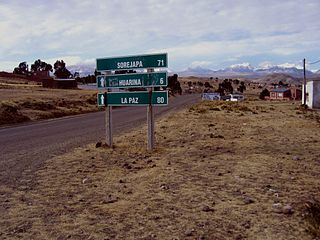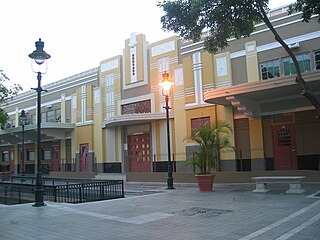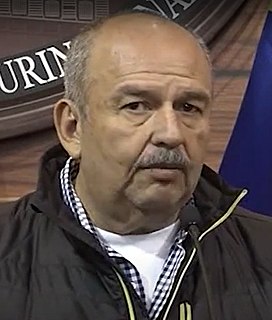
La Paz, officially known as Nuestra Señora de La Paz, and also Chuqi Yapu in Aymara, is the seat of government as well as the legislative and executive capital of the Plurinational State of Bolivia. With an estimated 816,044 residents as of 2020, La Paz is the third-most populous city in Bolivia. Its metropolitan area, which is formed by La Paz, El Alto, Achocalla, Viacha, and Mecapaca makes up the second most populous urban area in Bolivia, with a population of 2.0 million, after Santa Cruz de la Sierra with a population of 2.3 million. It is also the capital of the La Paz Department.
The national anthem of Bolivia, also known as Bolivianos, el Hado Propicio was adopted in 1851. José Ignacio de Sanjinés, a signer of both the Bolivian Declaration of Independence and the first Bolivian Constitution, wrote the lyrics. The music was composed by an Italian, Leopoldo Benedetto Vincenti.

Pedro Domingo Murillo is a province in the Bolivian La Paz Department. It was created on January 8, 1838, with the name Cercado and on October 17, 1912, during the presidency of Eliodoro Villazón, its name was changed in honor of Pedro Domingo Murillo, protagonist of the revolution of June 16, 1809.

Pedro Domingo Murillo was a patriot of Upper Peru who played a key role in Bolivia's independence.
Rodolfo Plaza Montero was born July 27, 1909 and was a Bolivian football player, businessman and revolutionary. He played in the amateur Federación Boliviana de Fútbol Club Bolivar and was the only player to become its coach and President from 1956 to 1963. He was a member of the national team and participated in the 1938 Juegos Bolivarianos.

El Alto Municipality or El Alto de La Paz Municipality is a municipal section of the Pedro Domingo Murillo Province in the La Paz Department, Bolivia. Its seat is El Alto, the second-largest city in Bolivia.

Calamarca or Qala Marka is the fourth municipal section of Aroma Province in the La Paz Department of Bolivia. It is located on the Altiplano and its seat is the town of Calamarca.

Colcapirhua is a town in the Cochabamba Department in central Bolivia. It is the seat of the Colcapirhua Municipality, the fifth municipal section of the Quillacollo Province.

Huarina is a location in the La Paz Department in Bolivia. It is the seat of the Huarina Municipality, one of the four municipalities of the Omasuyos Province. President of Peru Andrés de Santa Cruz was born here.

Plaza del Mercado de Ponce or, formally, Plaza del Mercado Isabel Segunda, is a historic marketplace building in Ponce, Puerto Rico. It was inaugurated in 1863 by Ponce Mayor Don Luis de Quixano. The building was designed by famed engineer Timoteo Luberza. The Plaza occupies a city block in the Ponce Historic Zone at the grid formed by Calle Atocha, Estrella, Leon, and Castillo streets. It has room for 65 kiosks. It was originally called "Plaza del Capá."

La Paz was founded in 1548 by the Spanish conquistadors at the site of the Native American settlement Laja; the full name of the city was originally Nuestra Señora de La Paz. The name commemorated the restoration of peace following the insurrection of Gonzalo Pizarro and fellow conquistadors four years earlier against Blasco Núñez Vela, the first viceroy of Peru. The city was later moved to its present location in the valley of Chuquiago Marka.

The city of La Paz, Bolivia is divided into seven main districts, called "Macro Distritos", which at the same time are divided into 21 small districts or zones. The city is commonly divided by the people into three main zones: South Zone, Central Zone and North Zone.

Plaza San Francisco a major urban plaza in the city of La Paz, Bolivia, and a frequent location for political gatherings and protests. It is located in front of the San Francisco Cathedral as well as the Lanza Market and the headquarters of the La Paz Factory Worker's Departmental Union Federation. The plaza was enlarged to 6,163 square meters in 2011. It was designated the city's Plaza Mayor, although this title had been used in the past for the Plaza Murillo. Together with 1,140 m2 Plaza Fabril constructed at the same time in front of the Factory Worker's Federatio, it constitutes the largest open public space in urban La Paz.
P'aquchi (Aymara) is a Bolivian folk dance. It is a satire of the fencing of the Spaniards during the colonial period.
The Unidad Táctica de Operaciones Policiales is the riot control unit of Bolivia's National Police. The unit was founded in 1976 as the Grupo Especializado de Seguridad. The unit has been involved in confronting numerous protests and civil disturbances, and provides security around the principal government buildings in La Paz, Bolivia's seat of government.

Cristina Corrales Real was a Bolivian journalist, radio broadcaster, and politician.

Arturo Carlos Murillo Prijic is a Bolivian businessman, hotelier, and politician who served as minister of government from 2019 to 2020. As a member of the National Unity Front, he previously served as senator for Cochabamba from 2015 to 2019 and as a plurinominal member of the Chamber of Deputies from Cochabamba from 2006 to 2010.

Wilfredo Franz David Chávez Serrano is a Bolivian lawyer, professor, and politician serving as the Attorney General of Bolivia since 12 November 2020 during the government of Luis Arce. He previously served as Minister of the Government from September 2011 to January 2012 during the government of Evo Morales.

The 1946 La Paz riots were a series of increasingly violent strikes and protests which culminated in the lynching and hanging of then president Gualberto Villarroel and the complete collapse of his government. The riots occurred in the Bolivian capital of La Paz between 8 and 21 July 1946. What started as teachers' strikes demanding increased wages quickly escalated as university students, organized labor workers, and civilians clashed with municipal police and armed, pro-government civilians. By the end, interim control of the country was handed to a junta of representatives of the three striking groups chaired by independent magistrates of the Superior Court of Justice of the judicial district of La Paz.














